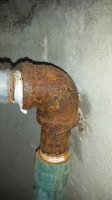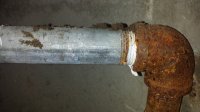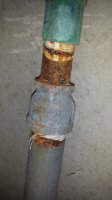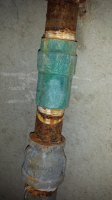Gtrshop
New Member
This is a problem I've been dealing with for some time.
I have a pump mounted on top of my water tank in the basement of my home. The inlet line runs 20' or 25' horizontally from where the line enters the house to the inlet of the pump (a Simler? Simer?). From where it enters the house to the well head is approximately 4 feet. This is all Black Plastic Pipe, with a grey plastic elbow to make the transition in direction 90 degrees.
Here's what happens: First thing in the morning the pump starts. Water will initially flow and then stop (this is the water that sits in the pipe when the pump isn't running). Because I've installed clear line in front of the pump for about 10 feet I can see that there is air in the line, and the pump is obviously cavatating. I can watch bubbles of air moving through the line upwards to the pump inlet. I can HEAR when air enters the pump, it sounds different. (I can see that the water isn't being drawn up far enough...there is a loop in the clear pipe so that we can move things around a bit to work....if water gets past the loop the pump will flow water). (Also, occasionally I can watch the water seems to "slip backwards" as if suction or something was lost). I crack the nut on the top of the pump, let the air out. (I am able to isolate the tank inlet from the pump outlet as I have a brass 1" valve between the two). I flood the pump from the tank using the valve, which pushes air out of the pump. Start pump and repeat priming 4,5,6....however many times it takes. I can watch the water flowing...or NOT flowing because of the clear line (reinforced). We have noticed that we will get prime back when the clear line starts to collapse onto itself. Now I know this is not ideal, this is just what is happening. I have no ideal if there is a check valve in this system, from everything I've seen so far there isn't one, but if I leave the system untouched for a couple days it will hold at 50PSI. So, I am thinking that a coupling (green in colour) that sits on top of the well pipe is actually a check valve. I can't get to the well head since there is a well tile and cap over it. ( That may be moved in the next day or so if I get enough muscle).
If I run the pump within an hour or so of re-priming it, it will usually hold prime and refill the tank. Filling the tank thats a long time. If I leave it unattended for 8 hours, I'll have to re-prime after getting home from work. The inlet line runs at about 3' off the floor until it transitions to clear line, which drops to the floor, then there is a small loop of clear, and the line runs up to the inlet of the pump. Where the BPP joins to the clear and it falls, while I'm running the pump and its primed, I can watch the water trickle and cascade down to floor level. The line is never full of water. (At this transition point I also installed a TEE and a valve so I could add water to the inlet line to re-prime. I had installed a check valve here, but that didn't do anything for me, and this was early on in my troubleshooting).
Asking other person about whats happening its been mentioned that I may have a leak somwhere, but I feel it's not between the pump INLET and the GREEN COUPLING (that might be a check valve) since pressure stays up when system not in use.
The sand point pipe transitions from a large pipe to a smaller diameter pipe which has the green coupling, and that I think is larger than then 1" line that enters the house, but I'm not 100% certain of that.
I guess I'm asking for a couple opinions, and perhaps how to tell if it could be the check valve that might be bad. It was mentioned to me that the valve might hold back pressure, but may have trouble opening.
I also want to mention that my water is very cloudy -with air. You can watch it fizz away in a glass. I believe that so much air is being cavatated that its being compressed into the water and then when the water leaves the tap it escapes, but the water looks very cloudy first. A tap mounted water filet removes the bubbles and the water is clear. I also have 2 filters - a 25 micron and a 5 micron after the first - located after the tank to remove the iron algae.
Feel free to ask for more details. I have some pictures that I could post too, just not here.
EDIT... this is the clearest picture of the green coupling I can get. Is this the check valve?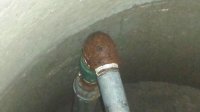
I have a pump mounted on top of my water tank in the basement of my home. The inlet line runs 20' or 25' horizontally from where the line enters the house to the inlet of the pump (a Simler? Simer?). From where it enters the house to the well head is approximately 4 feet. This is all Black Plastic Pipe, with a grey plastic elbow to make the transition in direction 90 degrees.
Here's what happens: First thing in the morning the pump starts. Water will initially flow and then stop (this is the water that sits in the pipe when the pump isn't running). Because I've installed clear line in front of the pump for about 10 feet I can see that there is air in the line, and the pump is obviously cavatating. I can watch bubbles of air moving through the line upwards to the pump inlet. I can HEAR when air enters the pump, it sounds different. (I can see that the water isn't being drawn up far enough...there is a loop in the clear pipe so that we can move things around a bit to work....if water gets past the loop the pump will flow water). (Also, occasionally I can watch the water seems to "slip backwards" as if suction or something was lost). I crack the nut on the top of the pump, let the air out. (I am able to isolate the tank inlet from the pump outlet as I have a brass 1" valve between the two). I flood the pump from the tank using the valve, which pushes air out of the pump. Start pump and repeat priming 4,5,6....however many times it takes. I can watch the water flowing...or NOT flowing because of the clear line (reinforced). We have noticed that we will get prime back when the clear line starts to collapse onto itself. Now I know this is not ideal, this is just what is happening. I have no ideal if there is a check valve in this system, from everything I've seen so far there isn't one, but if I leave the system untouched for a couple days it will hold at 50PSI. So, I am thinking that a coupling (green in colour) that sits on top of the well pipe is actually a check valve. I can't get to the well head since there is a well tile and cap over it. ( That may be moved in the next day or so if I get enough muscle).
If I run the pump within an hour or so of re-priming it, it will usually hold prime and refill the tank. Filling the tank thats a long time. If I leave it unattended for 8 hours, I'll have to re-prime after getting home from work. The inlet line runs at about 3' off the floor until it transitions to clear line, which drops to the floor, then there is a small loop of clear, and the line runs up to the inlet of the pump. Where the BPP joins to the clear and it falls, while I'm running the pump and its primed, I can watch the water trickle and cascade down to floor level. The line is never full of water. (At this transition point I also installed a TEE and a valve so I could add water to the inlet line to re-prime. I had installed a check valve here, but that didn't do anything for me, and this was early on in my troubleshooting).
Asking other person about whats happening its been mentioned that I may have a leak somwhere, but I feel it's not between the pump INLET and the GREEN COUPLING (that might be a check valve) since pressure stays up when system not in use.
The sand point pipe transitions from a large pipe to a smaller diameter pipe which has the green coupling, and that I think is larger than then 1" line that enters the house, but I'm not 100% certain of that.
I guess I'm asking for a couple opinions, and perhaps how to tell if it could be the check valve that might be bad. It was mentioned to me that the valve might hold back pressure, but may have trouble opening.
I also want to mention that my water is very cloudy -with air. You can watch it fizz away in a glass. I believe that so much air is being cavatated that its being compressed into the water and then when the water leaves the tap it escapes, but the water looks very cloudy first. A tap mounted water filet removes the bubbles and the water is clear. I also have 2 filters - a 25 micron and a 5 micron after the first - located after the tank to remove the iron algae.
Feel free to ask for more details. I have some pictures that I could post too, just not here.
EDIT... this is the clearest picture of the green coupling I can get. Is this the check valve?

Last edited:

